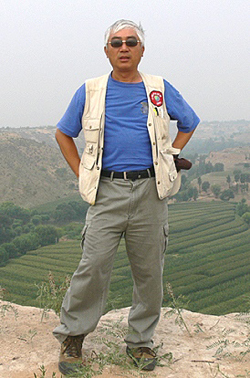| |
 |
|
|
 |
| |
 |
|
|
:::
NTU Department of Geosciences Research Results Honored by Publication in Recent Issue of the science journal Nature.
Information Provider:Professor Sheng-Rong Song(宋聖榮教授)
Translator:Professor Kirill Ole Thompson(唐格理教授)
In cooperation with a team from America, Japan, Germany and Taiwan, Professor Sheng-Rong Song(宋聖榮), Department of Geosciences, NTU, conducted research under the "Taiwan Chelongpu-fault Drilling Project," which successfully produced an "Earthquake Rupture Model" of the 921 Taiwan Chi-Chi Earthquake. This research result received the highest consideration of the National Science Council (NSC), and was reported in the internationally acclaimed science journal Nature on Thursday, November 23, 2006. (To view the article, visit:
www.nature.com/nature/journal/v444/n7118/full/nature05253.html.)
Funded by the NSC, a Taiwan Geoscience Research Team commenced work on this project at DaKeng, Taichung City on January 1, 2004. They drilled 2 km into the Chelungpu-fault zone and, by successfully retrieving fault core samples and making deep measurements, they investigated the causes of the gigantic seismic rupture activity at the Chelungpu-fault. Working tirelessly for two years, the research team finally issued their results.
|
|
Drilling down 1,111 meters, the "Taiwan Chelungpu-fault Drilling Project" research team successfully extracted a section of the Chi-Chi earthquake's fault slip surface. They discovered a 12 cm primary slip zone where seismic faulting had occurred at least 33 events. At the same time, the morphology at each zone was remarkably similar. This evidence shows that, not only do earthquakes recur; they like to recur at their favorite "old haunts". This fault research result provided direct and compelling evidence about possible repeat performances of major earthquakes at certain favored locations and related seismic rupture activity conditions. Moreover, the establishment of an accurate "Earthquake Rupture Model" was a major breakthrough for understanding earthquake behavior and predicting earthquakes.
Additionally, Taiwan had no experience in kilometer long continuous coring. Consequently, the plan to undertake 2 km continuous coring constituted a major milestone for local Taiwan scientific research conducted in Taiwan to respond to international scientific questions.
|
Professor Sheng-Rong Song, Department of Geosciences, NTU. (Photo taken in Inner Mongolia in August 2006.)
|
Copyright 2006 NTU Secretariat
|
|
Copyright © 2006 National Taiwan University
No. 1, Sec. 4, Roosevelt Road, Taipei, 10617 Taiwan(R.O.C.)
Phone: +886-2-3366-3366 Fax: +886-2-2362-7651
|

